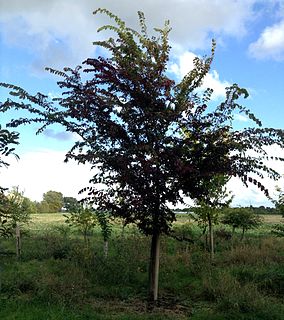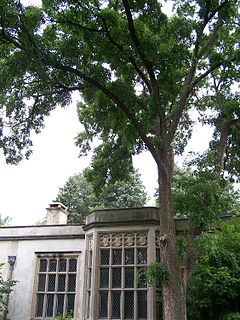Related Research Articles

Ulmus 'Frontier' is an American hybrid cultivar, a United States National Arboretum introduction derived from a crossing of the European Field Elm Ulmus minor with the Chinese Elm Ulmus parvifolia in 1971. Released in 1990, the tree is a rare example of the hybridization of spring- and autumn-flowering elms. Tested in the US National Elm Trial coordinated by Colorado State University, 'Frontier' averaged a survival rate of 74% after 10 years.

The hybrid elm cultivar Ulmus × hollandica 'Pioneer' is an American clone arising from the crossing of two European species, Wych Elm U. glabra and Field Elm U. minor. Raised by the USDA station at Delaware, Ohio, in 1971, 'Pioneer' was released to commerce in 1983.

Ulmus 'Morton' is an elm cultivar cloned from a putative intraspecific hybrid planted at the Morton Arboretum in 1924, which itself originated as seed collected from a tree at the Arnold Arboretum in Massachusetts. Although this tree was originally identified as Ulmus crassifolia, it is now believed to have been a hybrid of the Japanese elm and Wilson's elm. Accolade has proven to be the most successful cultivar tested in the US National Elm Trial, averaging a survival rate of 92.5% overall.
Ulmus 'Morton Plainsman' is a hybrid cultivar raised by the Morton Arboretum from a crossing of Siberian Elm and a Japanese Elm grown from openly pollinated seed donated by the Agriculture Canada Research Station at Morden, Manitoba. Tested in the US National Elm Trial coordinated by Colorado State University, Vanguard averaged a survival rate of 78% after 10 years.

Ulmus 'Morton Red Tip' is a hybrid cultivar raised by the Morton Arboretum from an open pollination of Accolade. The tree has occasionally been reported as a hybrid of Accolade with the Siberian Elm Ulmus pumila, an error probably owing to the commercial propagation of the tree by grafting onto U. pumila rootstocks. Tested in the US National Elm Trial coordinated by Colorado State University, Danada Charm averaged a survival rate of 77.5% after 10 years.
The American Elm cultivar Ulmus americana 'Patmore' was selected and raised by R. H. Patmore from a native tree in Brandon, Manitoba, Canada. It may be synonymous with another cultivar from the same source, known as 'Brandon'.
The Chinese Elm cultivar Ulmus parvifolia 'A. Ross Central Park' is probably the hardiest in cultivation and was patented in 1989 by David F. Karnosky. The original tree grew near the entrance to Central Park, at the junction of Fifth Avenue and 72nd Street in the Upper East Side of Manhattan in New York City, and died in the 1990s aged over 100 years. The cloning project was initiated in 1976 by the Arthur Ross Foundation, and executed by the School of Forestry and Wood Products, Michigan Technological University, Houghton.
The Chinese Elm cultivar Ulmus parvifolia 'Dynasty' is a United States National Arboretum introduction reputed to be very fast-growing.
The Chinese Elm cultivar Ulmus parvifolia 'Hallelujah' is one of three American introductions made circa 1992 that were selected for their cold hardiness. 'Hallelujah' is known to have withstood -37°C (-35°F) in Missouri.
The Chinese Elm cultivar Ulmus parvifolia 'Glory' is one of the early American selections, best known for its winter hardiness.

The American elm cultivar Ulmus americana 'Lewis & Clark' is a development from the North Dakota State University (NDSU) Research Foundation breeding programme, released in 2004 to commemorate the 200th anniversary of the eponymous expedition. The cultivar was cloned from a tree discovered in 1994 along the Wild Rice River south west of Fargo, ND., where all those around it had succumbed to Dutch elm disease; the tree remains in perfect health (2008). Prairie Expedition proved only moderately successful in the US National Elm Trial, averaging a survival rate of 62.6% overall, owing largely to environmental factors rather than susceptibility to Dutch elm disease.
The American Elm cultivar Ulmus americana 'Fiorei' was raised by the Charles Fiore Nurseries, Prairie View, Illinois, before 1956, but is no longer listed by the company.
The Chinese Elm cultivar Ulmus parvifolia 'D. B. Cole' was listed in the Arborvillage Farm Nursery Holt, Missouri, Catalogue of Fall 1991–Spring 1992, p.21.
The Chinese Elm cultivar Ulmus parvifolia 'Red Fall' is an American clone selected by S. Bieberich of the Sunshine Nursery, Clinton, Oklahoma.
The Chinese Elm cultivar Ulmus parvifolia 'State Fair' was cloned from a tree growing in the grounds of the Oklahoma State Fair, Oklahoma City.
The Chinese Elm cultivar Ulmus parvifolia 'Stone's Dwarf' was commercially released in the US in 1978.
The Chinese Elm cultivar Ulmus parvifolia 'The Thinker' was selected by M. Hayman from a tree on the campus of the University of Louisville, Kentucky.
The Chinese Elm cultivar Ulmus parvifolia 'Select 380' was tested in the United States for cold-hardiness. The name is considered invalid by some for want of fuller description.
The Chinese Elm cultivar Ulmus parvifolia 'Yarralumla' is a cultivar raised by the Yarralumla Nursery in Canberra, Australia.
The Chinese Elm cultivar Ulmus parvifolia 'Emerald Prairie' was raised by Kansas State University and released in 2004.
References
- ↑ Whitcomb, C. E. & Hickman, G. G. (1986), HortScience, 21: 162–163, 1986.
- ↑ Santamour, Frank S.; Bentz, Susan E. (May 1995). "Updated Checklist of Elm (Ulmus) Cultivars for use in North America". Journal of Arboriculture. 21 (3): 122–131. Retrieved 20 June 2016.
- ↑ "Elm Leaf Beetle Survey". Archived from the original on 2011-07-19. Retrieved 17 July 2017.